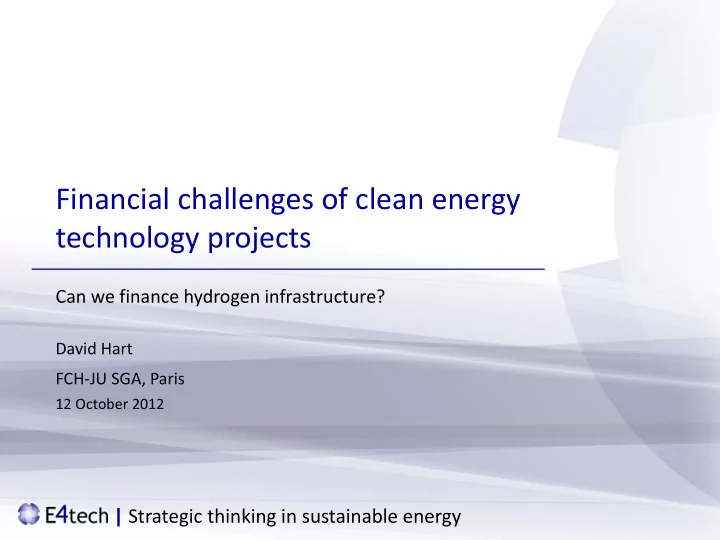

Financial challenges of clean energy technology projects Can we finance hydrogen infrastructure? David Hart FCH-JU SGA, Paris 12 October 2012 | Strategic thinking in sustainable energy
E4tech helps businesses, policy makers and technology developers with strategic issues in sustainable energy Successful sustainable energy solutions consider: - Competing technologies - Evolving policy environments - Business and finance imperatives E4tech’s objective analysis and expertise provide: - Evaluation of different risks in these disparate areas - Guidance under uncertainty - Support in taking the next steps 2
Financing new technology is difficult… • New technology brings risk and cost • It faces clear structural barriers versus the incumbent(s) • Agency splits complicate incentives • Landlord / tenant • National vs local mechanisms, costs and benefits • Anything requiring ‘big infrastructure’ is even trickier • Stranded assets Image: European Commission • Systems dependency/lock-in/network effects • And end-use consumer goods face different barriers from enabling services 3
…and it is hard to finance clean technology just because it is clean… • Social benefit : private cost • Energy is a commodity – few niche markets • Uncertainty • Boundary conditions (e.g. cross-border taxation) • Policy environment (e.g. feed-in tariffs) • Consumer uptake • Competing solutions (VHS, Betamax) Image: iStock • Financing the right part of the chain • Biomass power: do you finance the electricity, the plant or growing the fuel? • Incentives can have unintended consequences • European solar market support partly helped Chinese firms 4
Financing hydrogen infrastructure is harder still • Vehicles may be (fairly) straightforward to finance – not utilisation dependent • Make them desirable (comfort, performance, mains power offtake etc) • Reduce cost to affordable level • Provide public incentives to support uptake and build volume • Cash – subsidy, tax break etc (measurable per vehicle) • Benefit – free parking, congestion charge avoidance etc • Infrastructure is much harder – utilisation dependent Image: Royal Society for Chemistry • Needs demand/throughput, lacking initially (lower cost of fuel may not be enough) • The chain/risk has multiple owners • It’s local/regional not global so scale economics poor • First mover disadvantage – others can copy, or learn from mistakes • And hydrogen even more so: • Fuelling pressure, dispensing equipment, immeasurable contaminant levels… 5
However, infrastructure changes from the past offer lessons • UK switch to North Sea Gas in 1960s • Nationally-owned industry co-ordinated household-level equipment change to allow a different fuel Government financing allowed local costs to be absorbed for national benefits. End user benefit minimal • Establishment of mobile phone networks since 1980s • Government licenses limited number of market actors who raise private finance against future revenues Restricted competition creates business case for finance • US rural electrification in 1930s • Special Rural Electrification Agency loans to state / local governments, farmers' cooperatives, and nonprofits (not end users) to fund grid extensions Strong user benefit creates demand and willingness of intermediaries to aggregate demand and take on financing risk Images: Fagor, US DoE/NREL, European Commission 6
Can we learn from history and target the right areas for support? • Ideally unify incentives • OEMs and infrastructure providers are not equal • Break down the key areas of pain / risk and address in turn • Low early utilisation guaranteed cashflow (subsidise early fuel sales, tax later) • First-mover disadvantage solution (e.g. tradable station permits; geographic buffers) • Model cashflows in detail and decide what to finance • Flatten / share the pain and the gain • Think about non-traditional models • Allow as much modularity as possible to minimise up-front cost and maximise utilisation • Cross-finance high & low throughput stations • Sign up buyers in advance • Maintain international dialogue Image: CollegeView 7
Some options are more obvious than others • Attract new entrants: growth is easier to finance than cannibalisation • IGCs: Intelligently-enabled roaming tankers which visit the vehicle when parked • Power utilities: use ‘spare’ electricity to enter at specific locations • Supermarkets: with user fleets that can guarantee utilisation • Users pay in advance • Infrastructure premium per vehicle, recouped by infrastructure providers on fuel • Pre-paid fuel – like a leasing deal bundled with the car • Insurance for infrastructure costs • Station has throughput forecast, insured by an instrument paid for jointly by fuel and vehicle cos. Shortfall triggers payment to infrastructure provider • OEM CO 2 targets/credits used to make tradable instruments for infrastructure • Set up owners’ co -operatives to fund local fuelling stations • Find a sugar daddy – or a group of them 8
Thank you david.hart@e4tech.com | Strategic thinking in sustainable energy 9
Recommend
More recommend